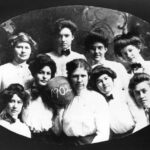Hair Lair: On the Harry Ransom Center’s Lot of Locks

Ezra Pound’s hair, which would later grow as dark as his fascist views, is thick and blond, collected from his innocent, 4-year-old head. Percy Shelley’s lock is a fragile and elegant amber wisp curled into a U, clipped shortly before the Romantic poet’s drowning death. Walt Whitman’s is a loose scattering of fine, gray strands, plucked, postmortem, from the transcendentalist’s head and given to his housekeeper Mary O. Davis.
Though you can’t run your fingers through your favorite dead author’s hair anymore—oily fingers can degrade the artifacts, and thus the samples are now kept in Mylar—the Harry Ransom Center is the final resting place for dozens of shorn manes once attached to some of history’s most remarkable figures.
Odd? Perhaps. But not for the time. In the 18th and 19th centuries, it was normal to collect locks of hair garnered from loved ones and famous writers, musicians, and statesmen. And considering the Ransom Center has items like Edgar Allan Poe’s writing desk, it would stand to reason that they’d also have a tuft of his hair, right?
These three poets, for example, united under one roof on campus with other historical figures like Napoleon, two Brontë sisters, and George Washington, at one point in their lives (or shortly thereafter) had samples of their hair taken from atop their heads, for a wide range of reasons. Pound’s lock is family-related, saved in 1890 the same way baby teeth might be kept today. Shelley’s, collected in an envelope bearing a green marking reading “139” is possibly the work of a collector, to be sold as a more intimate, pre-Victorian version of an autograph. Whitman’s was taken as a remembrance, as hair, made out of a protein called keratin, doesn’t naturally decompose.

In these ways, hair as an artifact is more than just an amusement. During the Victorian era, cholera, smallpox, and other archaic diseases drove life expectancy down. Treatment often included shaving the head of the afflicted, which was kept to make wigs, or, if the person ended up dying, sometimes kept as a personal, everlasting piece of the deceased.
“These were given as remembrances, or, memento mori for relatives who had passed,” Ransom Center Associate Director and Hobby Foundation Librarian Jim Kuhn says. “It was also common for 19th century hair to be turned into jewelry.”
The hair would serve either as a component, or, in the case of British cult leader Joanna Southcott, the only component. As part of the Southcott collection, the Ransom Center owns a tiny ring fashioned completely out of her midnight-black locks.
“It was a fad to belong to her cult,” Research Associate Elizabeth Garver says. “We have these long scrolls of her members. They would get these seals that were their passport into heaven, and she had this ring she would stamp them in with. This isn’t that ring, but it’s her hair.” Southcott died at 64 in 1814, shortly after declaring she was pregnant with the new messiah.
The centerpiece of the collection is a scrapbook, compiled by Romantic poet Leigh Hunt, containing 21 sets of locks, and a portrait of each subject. At some point a man named John Hoole—friend of his contemporary Samuel Coleridge—sold or gave Coleridge the book, including the hair of John Milton and Jonathan Swift. He then added to the Hoole collection with locks from his fellow Romantics John Keats, William Wordsworth, and Coleridge. There are entries from after Hunt’s death, in 1859, showing that someone, likely a Hunt family member, took up his task and made it their own. In 1921, the book was bought at a Sotheby’s by Miriam Lutcher Stark, who eventually donated it to The University of Texas.
Some of Hunt’s collection is mainly or completely lost to time, or, in the case of the Milton sample, unable to be authenticated. Of George Washington and Napoleon, the world leaders who overlapped as the 18th century became the 19th, only minute strands remain. Keats, according to the documentation provided, is balding, down from two locks to one in the collection. It’s a fascinating, only mildly creepy snapshot of collector life in the years surrounding Queen Victoria’s reign.
In some cases, even more interesting to a librarian or researcher is the documentation that comes with the hair to authenticate it. According to Garver, dealers would scam collectors with inauthentic locks. The final owner of the Charlotte Brontë piece sought to prove its actual value. A card presented with the donation, reads, “from E. Nussey.” Below that, simply: “the above is Miss Ellen Nussey’s handwriting.”
“Nussey is one of Brontë’s best friends,” Garver says. “We have a chain of authentication here,” Kuhn says. There’s another notable reason people wrote on the backs of envelopes containing the flowing locks of a vaunted poet or the first president. It’s the same reason that the selfie has replaced the autograph (and the lock of hair) as the de-facto celebrity get.
With multiple people writing on the packaging, Kuhn says, “it’s not just to authenticate it; they’re adding their own identity. It’s also their brush with greatness.”
From top: Poe’s hair, collected in a locket; a page from Leigh Hunt’s book. Courtesy the Harry Ransom Center.










No comments
Be the first one to leave a comment.